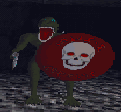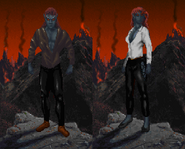Template:Eras The Elder Scrolls: Arena was released in 1994 and was the first game of the The Elder Scrolls series and 12th game developed by Bethesda Softworks. It was one of the first role-playing video games and one of the largest games created at the time of its release. In 2004, a downloadable version of the game was made available free of charge as part of the 10th anniversary of The Elder Scrolls series, but newer systems may require an emulator such as DOSBox to run it, as Arena is a DOS-based program.
Like its sequels, Arena takes place on the continent of Tamriel, complete with wilderness, dungeons, and a spell creation system that allows players to mix various spell effects into a new spell as long as they have the money to pay for it.
Although not as popular as the later games, Arena generated a cult following, and it was successful enough to spawn a sequel, Daggerfall.
Development
Map of Tamriel in Arena.
Arena was originally supposed to be a game of gladiatorial combat. The player was to take his team of gladiators and would travel about a world fighting other teams in their arenas until the player became "grand champion" in the world's capital. Along the way side-quests and various role-playing aspects were added. Eventually these side-quests became more important than the tournament aspects, so the tournament part of the game was discarded, and Arena became a "full-blown RPG".
It sold slowly, but steadily, and despite harsh reviews, general bugginess, and the considerable demands the game made on players' machines, the game became a cult hit. Because all the material had already been printed up with the title "Arena", the game went to market as The Elder Scrolls: Arena. The name turned into being a nickname for the world, since the Empire of Tamriel was so violent.
Missing their Christmas 1993 deadline, the game was released in the "doldrums" of March 1994, which was considered a bad time to release a game for a small developer like Bethesda. The misleading packaging further contributed to distributor distaste for the game, leading to an initial distribution of only 3,000 units.
When the game launched it was initially very buggy, being very difficult if not impossible to complete the main quest in the original, non-patched version of the game. Bethesda released a number of patches to fix almost all of the glitches, making the game finish-able and more stable.
Versions
Arena was originally released on CD-ROM and 3.5" floppy disk. The CD-ROM edition is the more advanced, featuring enhanced speech for some characters and CGI video sequences.
In late 1994, Arena was re-released in a special "Deluxe Edition" package, containing the CD-ROM patched to the latest version, a mouse pad with the map of Tamriel printed on it, and the "Codex Scientia"; an in-depth hint book.
The version that was released as freeware by Bethesda Softworks in 2004 is the 3.5" floppy disk version, not the CD-ROM edition.
It had gotten a re-release on September 10th 2013 in a collection with the other four games in the main series. It is the exact version as the original, yet unlike the downloadable free version, this bypasses the dosprompt entirely.
Gameplay
A typical dungeon in Arena.
The actual game-world is substantially larger than Morrowind, Oblivion, and Skyrim together. The game utilizes randomly generated content to generate a massive world (around 6 million square kilometers), without much effort on the developers' part. The world has hundreds of towns made with actual design, rather than being random, containing businesses with random names (Examples being "Gold Sword" "Silver Gauntlet" etc.) As well as several hundred dungeons, along with 17 specially designed dungeons that were part of the game's main quest.
Due to the enormity of the world, fast travel is essential. Walking to a nearby town could take up to 10 hours of real time, while a far off town in another province could take several days.
The game is played from a first-person perspective. Combat is performed by clicking the right mouse button and dragging it across the screen, as if swinging your weapon. Magic is used by clicking on the magic menu, selecting your spell, and clicking where you want to shoot it. There is also the ability to pickpocket people on the street, or break into a store at night.
Arena was one of the first games to have a day and night cycle, with stores closing at night, people getting off the streets, and monsters (Orcs, Lizard Men, etc.) wandering around towns at night.
The actual main quest is completed by finishing all 17 developer-made dungeons and completing the Staff of Chaos, but there are other quests as well. Asking about rumors in a town will lead to someone telling you about someone in a bar that may need help. These "miscellaneous" quests are very simple, ranging from simple delivery missions to finding an artifact item after going through a dungeon.
Another notable fact about Arena is that it has a tendency to be unforgiving towards newer players. It is easy to die in the starting dungeon, as powerful enemies can be encountered if the player lingers too long. However, this effect slowly withers away as the player becomes more powerful and more aware of the threats that loom everywhere. Even Ken Rolston, lead designer of The Elder Scrolls III: Morrowind, says he started the game at least twenty times and only got out of the beginning dungeon once.
Plot summary
The Emperor summons the Imperial Battle Mage, Jagar Tharn on rumors of treachery. But Jagar Tharn betrays him, and transports the Emperor into another dimension of his choosing. Tharn's apprentice, Ria Silmane, witnesses his treachery and tries to warn the Elder Council, but is killed by Tharn, her corporeal form being destroyed by the Staff of Chaos. After months of planning, Jagar Tharn transforms himself into the image of the Emperor and takes the throne, summoning demon minions and transforming them into the Emperor's Guard, and sending the head of the Imperial Guard, Talin, into the Imperial Dungeons to die. Ria Silmane becomes an incorporeal form through the use of magic and remains in this world so that she can warn Talin of Jagar Tharn's treachery and that the Emperor is actually Jagar Tharn in disguise. Ria creates a key for Talin to escape his cell and teleports him to another province through the use of a Shift Gate. The only way to stop Jagar Tharn is to obtain the Staff of Chaos, in which he holds his lifeforce. But the staff has been split by Tharn into eight pieces and scattered across Tamriel. Since Talin is the only one that Ria Silmane could trust, it's up to him to reassemble the pieces and defeat Jager Tharn.
Jagar Tharn takes the throne.
Finally, in 3E 399, after a long quest to reassemble the pieces, which were hidden at the bottom of a dungeon in each province, Talin finally reassembles the Staff of Chaos. However, Jagar Tharn was not defeated like Talin and Ria Silmane had hoped. There was one final piece in the Imperial Palace, the jewel to the Staff, which would make it complete. Talin fought his way through the Imperial Palace to the basement level where he fought with Tharn. Talin touched the staff to the jewel and they formed instantly, melting Jagar Tharn. The staff creates a portal automatically to the dimension in which the Emperor and General Warhaft are being held. They fall out of the portal and thank Talin. The Emperor makes him the Eternal Champion as a reward for saving them and defeating Jagar Tharn.
Quests
World
Character Information
Gameplay Information
Damage
Downloads
Trivia
- In the opening cinematic, the Emperor is referred to as Uriel Septim IV, instead of Uriel Septim VII.
- Arena can now be downloaded off of the Elder Scrolls website for free using MS-DOS systems such as DOSBox.
External links
- Free official download, from The Elder Scrolls official site
- Latest patch, v1.06
- "Arena" storyline - more info
Gallery
References
| Main Series | |
|---|---|
| Spin-offs | |
| General | |
| Travels | |
| Online | |
| Daedric War: | |
| Season of the Dragon: | |
| Dark Heart of Skyrim: | |
| Gates of Oblivion: | |
| Legacy of the Bretons: | |
| Shadow Over Morrowind: | |
| Legends | |
| Strategy Guides | |
| Books | |
| Merchandise | |





